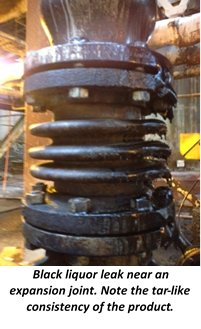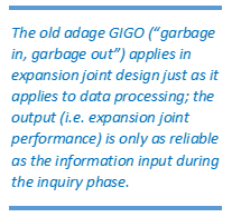Papermaking: Selecting the proper alloy for expansion joints
By: Frank Caprio | On: July 18, 2019

Yes, it’s liquor, but don’t drink it!
First, let’s quickly review the different types of liquor produced during papermaking. These cooking liquors can be alkaline-based (Sulfate) or acid-based (Sulfite).
In the Kraft/Sulfate process, wood chips are cooked in the digester unit, where they are mixed with steam and a chemical called white liquor, which breaks the chips down into fibers by dissolving the lignin that binds them together. The cooking chemicals are separated, then the pulp is washed with water to remove residual chemicals. This wash water is then combined with the spent cooking liquor to produce weak black liquor.
 The weak black liquor is dehydrated and concentrated until it becomes strong black liquor, which can be used as a fuel much like oil. It is combusted in a recovery boiler, where the combustion residual (“smelt”) collects in the bottom of the furnace. The smelt is recovered and dissolved in water, forming green liquor. This green liquor is treated with quicklime, which converts the green liquor into … white liquor!
The weak black liquor is dehydrated and concentrated until it becomes strong black liquor, which can be used as a fuel much like oil. It is combusted in a recovery boiler, where the combustion residual (“smelt”) collects in the bottom of the furnace. The smelt is recovered and dissolved in water, forming green liquor. This green liquor is treated with quicklime, which converts the green liquor into … white liquor!
Recovery and reuse of these cooking liquors and the quicklime reduce the environmental impact of papermaking, but this does not mean that papermaking is a clean process. There are many pollutants and by-products that must be removed or remediated. The Sulfite/acidic papermaking process is similar to the Sulfate process, but produces cooking liquors with different properties (brown liquor et al).
Not only can cooking liquors can be either alkaline or acidic, but the exact composition of the pulp, liquors, and pollutants vary with each facility due to differences in pulpwood and the processes employed. Hardwoods (i.e. maple, eucalyptus, aspen, birch, et al) have shorter fiber lengths than softwoods (pine, spruce, and other conifers). Shorter fibers produce smoother, writing-grade papers while longer fibers generally produce stronger, tear-resistant papers.
Many paper mills also use recycled fiber as a feedstock. The different grades of paper, cardboard, fluff pulp, etc. all need to be produced using different pulpwood, equipment, and processes, including the cooking liquors. Even two mills making the same end product can have significantly different equipment and processes, resulting in different chemistry in their cooking liquor.
UVCB and its meaning
This is why the customer needs to provide accurate chemical data instead of asking us to guess. Technical papers list the “normal” specific gravity of green liquor in a storage tank at around 1.16-1.19 (slightly heavier than water), and this may be “good enough” of an estimate in order to design an expansion joint. However, green liquor can be present in states ranging from vapors to liquid to dregs, and with differing chemical compositions from mill to mill. Black liquor’s specific gravity can vary greatly as well, depending on the degree to which it has been condensed.
The pulp mill’s chemists must know the chemical composition of the cooking liquors, as this data is used to adjust their production processes. The guys in maintenance don’t always have access to this data, and should seek this information from the chemists. If we consult chemical databases in order to obtain the properties of black or green liquor, the designator “UVCB” is cited. This is an abbreviation meaning “Unknown or Variable compositions, Complex reaction products and Biological materials”. This is another way of saying “we have no idea whatsoever.” Or, more appropriately, this notation means that the variable composition of the material cannot be classified as having specific properties. These resources cannot be used as a reliable source of chemical data.
More than just corrosion must be considered …
For our expansion joint inquiry mentioned above, we need the customer to provide the specific gravity, so that vibration and flow analysis calculations can be performed accurately. Additionally, the chemical composition of the media should be specified in order for us to use materials that will best resist corrosion once put into service. If the  customer cannot provide the chemical data along with their inquiry, then the design may not be optimal for that product. Also, if media with a high solids content (like green liquor dregs) is being transferred, the expansion joint might require a liner to prevent the solids from damaging the convolutions.
customer cannot provide the chemical data along with their inquiry, then the design may not be optimal for that product. Also, if media with a high solids content (like green liquor dregs) is being transferred, the expansion joint might require a liner to prevent the solids from damaging the convolutions.
The old adage GIGO (“garbage in, garbage out”) applies in expansion joint design just as it applies to data processing; the output (i.e. expansion joint performance) is only as reliable as the information input during the inquiry phase. This information helps us in selecting the proper alloy for expansion joints to best fit the application.
If you need help getting all the right information the first time around, let us know by contacting us today. We’ll help to make sure that the liquors your customer uses won’t end up giving you a bad case of head-spins!
Copyright 2019, Hose Master, LLC
All Rights Reserved

